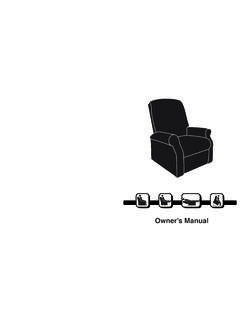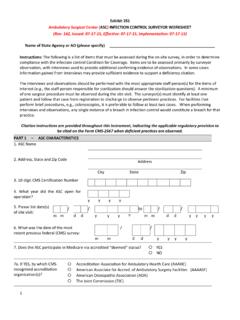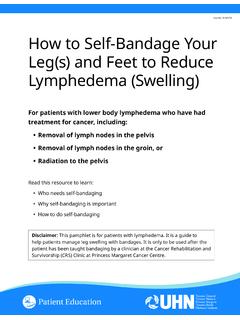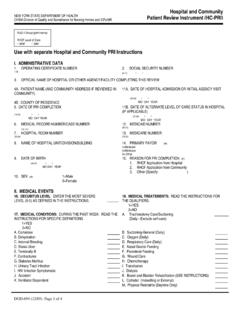Transcription of Trochanteric Bursitis – Self Management for Patients
1 Trochanteric Bursitis self Management for Patients Updated May 2010. What is the Trochanteric Bursa? The Trochanteric bursa is a fluid-filled sac that functions as a gliding surface to reduce friction between the bony prominence on the outside of the thigh bone (greater trochanter) and the muscles that lie over this bone. What is Trochanteric Bursitis ? It is a common cause of hip pain due to inflammation of the Trochanteric bursa. Trochanteric Bursitis is characterised by aching pain over the outer aspect of the hip with tenderness at the point of the hip.
2 The pain may be worse at night, when lying on the affected hip, or when getting up from a chair. The hip joint itself is not involved. It is more common in women and with increasing age. What causes Trochanteric Bursitis ? Overuse: Athletes who participate in sports which involve running or prolonged pressure may cause repetitive irritation of the bursa. Trauma: A fall onto the outer / upper thigh or bumping your hip on the edge of a table may cause inflammation of the bursa. Overweight: Excess weight increases stress on the bursa.
3 Inflammatory conditions: Such as polymyalgia rheumatica, rheumatoid arthritis. Surgery: Hip surgery may cause some irritation of the bursa. Bone spurs: Hip bone spurs or calcium deposits in the tendons which attach to the trochanter may irritate the Trochanteric bursa. An X-Ray will rule out bone spurs or areas of calcification which could be contributing to your problem. your self Management Programme Modify your activities Rest ONLY from sports or activities which aggravate your symptoms Avoid lying on your affected side When lying on your unaffected side, place a pillow between your knees as this relieves pressure on the bursa Anti-inflammatory Medications Anti-inflammatory medications will help to reduce pain and inflammation and are available in oral and topical from.
4 Speak with your regarding prescription of these medications. Massage Massage warm olive oil deeply into the painful area 4 times a day. This will help desensitise the bursa. Ice Apply ice (wrapped in a damp towel to prevent an ice-burn) to the painful area for 20 minutes. This will help to reduce pain and inflammation. Do not apply ice for longer than 20 minutes. Use ice after exercise and before you go to bed. Remove the ice immediately if you experience any discomfort. Home Exercise Programme (HEP) - Exercises should be performed 4 times daily.
5 Strengthening and Stretching Hip abduction Stand holding on to a support. Lift your affected leg out to the side, hold for 5 seconds. Then bring it back down slowly. Ensure you bring your leg as far out to the side as possible keeping your trunk straight throughout the exercise. Repeat 10 times. Repeat with the unaffected leg. This exercise can be progressed by moving your leg slightly forwards and backwards while holding your leg out to the side. Hip extension Stand holding on to a support. Bring your affected leg backwards keeping your knee straight.
6 Do not leaning forwards. Slowly return your leg to the start position. Repeat 10 times. Repeat with the unaffected leg. Hip Flexors Stretch Lie on your unaffected side with your knees bent. Take hold of the ankle of your upper leg with your hand or use a towel around your ankle. Gently draw your foot towards your buttock. Feel the stretch in the front of your thigh. Hold for 20 seconds. Repeat 5 times. IF YOU HAVE HAD A TOTAL HIP REPLACEMENT DO NOT CARRY-OUT. THE FOLLOWING STRETCHING EXERCISE. Iliotibial band stretch Sit on the floor with your unaffected leg straight and your affected leg crossed over it.
7 Bring the knee of your affected leg towards your opposite shoulder until you feel a comfortable stretch in your buttock. Hold for 20 seconds. Repeat 5 times. You should progress your by increasing the number of repetitions as able Swimming - Attend the swimming pool daily. Hip strengthening exercises - Carry-out hip abduction and extension strengthening exercises as described above in the pool. Ensure you stand holding on to support at the side of the pool. Front and back crawl Avoid the breaststroke Benefits of the self Management Programme Most Patients who follow this Management will - Reduce pain and inflammation Improve / maintain flexibility and muscle strength Maintain mobility Prevent disability and recurrence Patients who do not rest from their activities until the inflammation subsides or return too aggressively to activity may have a return of their symptoms.
8 Some tips: Avoid repetitive activities that put stress on your hips. If you are overweight, lose weight. Maintain strength and flexibility of your hip muscles. Physiotherapy If you have followed your self Management programme and your symptoms have not subsided, a course of physiotherapy may help you with the Management of your problem. The physiotherapist will assess and advise you on progression of your home exercise programme. The physiotherapist can also use various techniques to help reduce your pain and inflammation, such as, soft tissue massage.
9 Alternative Treatments for Trochanteric Bursitis Cortisone injections If after following the self Management programme and attending a course of physiotherapy your symptoms have not reduced, injection therapy is an option. The injection should provide pain relief. You will need to discuss this with your surgeon. Surgery Surgical treatment for Trochanteric Bursitis involves the removal of the bursa (bursectomy) and is rare. Contact Details: Jacinta O'Sullivan (Secretary to Mr. Carton). Telephone: 051319898.
10 Fax: 051 359919. Email: Shane Walsh (Physiotherapist). Telephone: 051 337431. Email: For further information on hip and groin conditions please visit our website Mr. P Carton MD FRCS (Tr&Orth). Consultant Orthopaedic Surgeon, Specialist in Hip and Groin Surgery Hip and Groin Clinic, Waterford.






